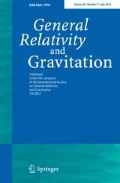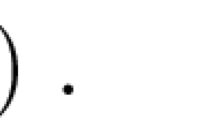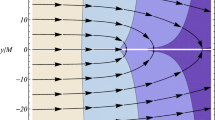Abstract
An explanation is proposed for the fact thatpp-waves superpose linearly when they propagateparallelly, while they interact nonlinearly, scatter andform singularities or Cauchy horizons if they areantiparallel. Parallel pp-waves do interact, but ageneralized gravitoelectric force is exactly cancelledby a gravitomagnetic force. In an analogy, theinteraction of light beams in linearized generalrelativity is also revisited and clarified, a new result isobtained for photon to photon attraction, and aconjecture is proved. Given equal energy density in thebeams, the light-to-light attraction is twice thematter-to-light attraction and four times the matter-to-matterattraction.
Similar content being viewed by others
REFERENCES
Kramer, D., Stephani, H., MacCallum, M. A. H., and Herlt, E. (1980). Exact Solutions of Einstein's Field Equations (Cambridge University Press, Cambridge).
Bonnor, W. B. (1969). Commun. Math. Phys. 13, 163.
Aichelburg, P. C. (1971). Acta Phys. Austriaca 34, 279.
Griffiths, J. B. (1991). Colliding Plane Waves in General Relativity (Clarendon Press, Oxford).
Tolman, R. C., Ehrenfest, P. and Podolsky, B. (1931). Phys. Rev. 37, 602; Tolman, R. C. (1934). Relativity, Thermodynamics and Cosmology (Clarendon Press, Oxford).
Will, C. M. (1993). Theory and Experiment in Gravitational Physics (revised ed., Cambridge University Press, Cambridge).
Wheeler, J. A. (1955). Phys. Rev. 97, 511.
Power, E. A., and Wheeler, J. A. (1957). Rev. Mod. Phys. 29, 480; Brill, R. D., and Wheeler, J. A. (1957). Rev. Mod. Phys. 29, 465; Ernst, F. J. (1957). Phys. Rev. 105, 1662; 1665; Rev. Mod. Phys. 29, 496; Wheeler, J.A. (1961). Rev. Mod. Phys. 33, 63; Wheeler, J.A. (1962). Geometrodynamics (Academic Press, New York); Brill, R. D. and Hartle, J. B. (1964). Phys. Rev. 135, B271.
Sorkin, R. D. et al. (1981). Gen. Rel. Grav. 13, 1127.
Sokolov, S. N. (1992). Gen. Rel. Grav. 24, 519.
Cooperstock, F. I., Faraoni, V., and Perry, G. P. (1996). Int. J. Mod. Phys. D 5, 375; Anderson, P. R., and Brill, D. R., (1997). Phys. Rev. D 56, 4824.
Wald, R. M. (1984). General Relativity (University of Chicago Press, Chicago).
Jantzen, R. T., Carini, P., and Bini, D. (1992). Ann. Phys. (NY) 215, 1.
Schneider, P., Ehlers, J., and Falco, E. E. (1992). Gravitational Lenses (Springer-Verlag, Berlin).
Jackson, J. D. (1962). Classical Electrodynamics (Wiley and Sons, New York).
Penrose, R. (1965). Rev. Mod. Phys. 37, 215.
Ferrari, V., Pendenza, P., and Veneziano, G. (1988). Gen. Rel. Grav. 20, 1185.
Cooperstock, F.I. and Faraoni, V. (1993). Class. Quantum Grav. 10, 1189.
Garriga, J. and Peter, P. (1994). Class. Quantum Grav. 11, 1743.
Author information
Authors and Affiliations
Rights and permissions
About this article
Cite this article
Faraoni, V., Dumse, R.M. The Gravitational Interaction of Light: From Weak to Strong Fields. General Relativity and Gravitation 31, 91–105 (1999). https://doi.org/10.1023/A:1018867405133
Issue Date:
DOI: https://doi.org/10.1023/A:1018867405133




